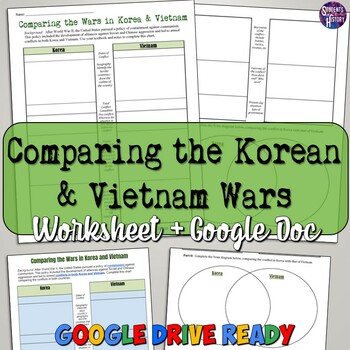Comparing the Vietnam and Korean Wars Worksheet
- PDF
- Google Apps™

What educators are saying
Description
This great Vietnam War and Korean War Comparison Worksheet has students use higher-level thinking skills to compare the Vietnam War to the Korean War. In 2 simple columns, students respond to a variety of prompts about the two conflicts against the spread of communism.
Examples of prompts include: the dates, causes, geography, key players, casualties, outcome, and more! Following the comparison chart, students complete a Venn diagram comparing the Korean and Vietnam Wars (or conflicts to be specific).
An online reading is linked for students to use as well as an editable Google Doc version of the activity.
An answer key is included for your convenience!
Thanks for looking!
Please "Like" my page on Facebook for updates, giveaways, links and more! Thanks!





